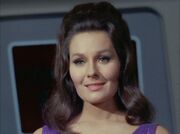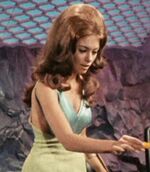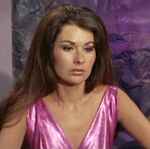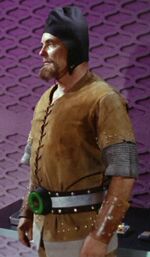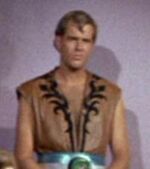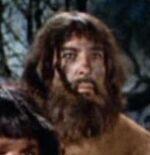
This is really an amazing issue. As I intimated in the last post, Marston and Peter seem to be getting more and more adroit at integrating layout and narrative, and there are some absolutely stunning spreads in this issue.

The color here is amazing, and the diaphanous, ghostly bodies really show off Peter’s supple lines. There’s a great contrast, too, between the airy grace of the female figures and the caricatured, cartoony old man (that’s the evil Pluto) at the top of the first page. Peter has also loosened up his layouts again, using bigger and fewer panels, and dividing them up in more varied ways than has been his wont up till now. Also notice in the upper right of the second page, there’s actually a wordless action sequence. I think that’s the first one in the series, and it’s really a joy to see Peter working without all those cumbersome text boxes for once. There’s another wordless sequence later in the comic; hopefully we’ll see more of it in later issues as well.
Also, so many great details here. The weird test tube with those evil black figures lurking around it, all against that gorgeous orange background…Peter’s use of motion lines is lovely as always….and the movement of the green girl in WW’s arms is perfectly done; she looks entirely limp and yet rigid a the same time, with her stylized hair and gown flowing out behind WW.
I think this one may even be better:

Again, the motion lines become an intense design element; it’s almost like you’re looking at rapids with all the racing, turbulent patterns going every which way and yet still managing to form a coherent whole. The upper left panel, with WW and the Holiday girls spinning semi-conscious in cocoons against that weird abstract colored background is especially fine — and, of course, with its hints of helplessness and semi-involuntary transformation, intentionally fetishized.
If Peter has outdone himself, Marston also turns in a fine story, somewhat more ominous and dark than usual In traversing the planets and the Greek gods, he’s inevitably come to Pluto, and so he gets to retell the Persephone rape legend

and replay it using one of the Holiday girls as the unfortunate Persephone.

This is preceded by a suggestive sequence:

You have the threatened rape, the disbelief of the other girls…and then the tearful evocation of fatherly displeasure, followed by the actual rape, complete with discarded phallic accoutrement. We’re treading around issues of incest and abuse, with Pluto taking the part of rapist/ogre/father.
That would explain in part, too, some of the more ominous submerged themes in the issue. When they get to the planet Pluto, for example, the Holiday girls and WW are confronted by black, groping hands. The hands hold them while they are split apart into spiritual light bodies and physical black bodies.

So bifurcated, the girls are held under Pluto’s thrall:

What happens at that point is a little unclear, but if I understand right, Pluto uses the light bodies as decorations in his castle while the dark bodies becomes his hollow, robed servants. In any case, the separated forms are definitely in his service, and easier to destroy than whole selves.
Thematically, the evil black hands, the split between beautiful beloved colorful spirits and despised hollow black drones, the narrative quest to reunite the two — it all seems like it’s dealing with sexual trauma, and the subsequent sense of estrangement from, and loathing of, the self. It’s mixed in, too, with Marston’s odd theories about the power of colors (theories I don’t pretend to entirely understand), and with his usual male/female binaries (the spiritual forms actually seem more female than the abandoned physical, blackened shells — which makes sense since masculine/feminine is more archetype than physical reality for Marston.) The result is a narrative that veers vertiginously between (literally) colorful fantasy and a disturbing darkness, with a sense that love can slide from one into the other at a moment’s notice. For instance, look at these successive pages:


The color palette kind of tells you everything you need to know, almost without even reading it.
There’s another telling sequence late in the book I think. Pluto comes to steal Steve away. The story spends an unusual amount of time not on Steve’s reaction, but on his secretary’s:


Narratively, there isn’t a need for all this; why do we care about the secretary’s reaction, after all? And why is she quite so thoroughly freaked out? (I mean, yes, I’d be freaked out too, but in terms of the stuff that happens on a regular basis in this comic, this is pretty small beer.) I think the answer to both questions, maybe, is that this is important, and she’s freaked out, because it’s a primal scene…and more importantly, a primal scene as site of abuse. It’s not just a kidnapping; it’s a rape, and a rape linked to childhood abuse and perversion (it’s a male on male intergenerational rape, after all.) The secretary, in effect, is necessary because you need not only the rape, but *the witness to the rape*; not only the (child) abuse but the traumatized child-adult.
Given Marston’s usual ways, I think it’s valid to wonder if he’s fetishizing father/daughter rape. There’s probably a touch of that in a scene like this:

At the same time….I think I’d argue that this sort of scenario (submerged rape themes, submerged incest themes) probably has a fair amount of appeal for girls as well as for dirty old men…especially when the girls are as clearly the heroes, the older men are as clearly the villains, and the incest/rape is as sublimated as is the case here. Relationships between fathers and daughters — or, perhaps more to the point, between patriarchy and daughters — are definitely fraught. The patriarchal power is desirable and exciting, and yet (and because) it’s forbidden for girls. Marston’s providing a way around that; he’s saying that you can be like Wonder Woman, and keep hold of the danger and the excitement and the sex without having to split against yourself and become a patriarchal thrall/ornament. There’s a sense, in other words, in which I think Marston’s fetishization of feminism is appealing not only to men, but to women as well, since women, like men, are invested in both sex and power relations as desirable commodities.
Which isn’t to say that it’s not a tricky and uncomfortable issue. Freud started thinking about female incest and rape fantasies in the context of his own female patients, most of whom were the daughters of his colleagues. They all claimed they’d been raped by their fathers. Freud was like, well, of course, their fathers didn’t rape them, because they’re my friends, so…women must have incest fantasies. Which is bullshit; I have little if any doubt that his patients were in fact raped by their fathers. And yet…at the same time that they do actually get raped and abused, by their fathers and others,…many women also do have actual rape fantasies, and fetishized relationships with (sometimes abusive) father figures. Marston’s story here seems to be about acknowledging and enjoying those fantasies (or even those realities) in order…I don’t know, maybe not to transcend them, but to not let them cripple you. In this context, it’s interesting that for Marston the reintegration is actually sexualized as well:

I said above the Marston seemed to be sexualizing the helplessness of the transformation…but on second thought, I wonder. Maybe it’s the duality itself that he finds sexy; the image of women as both spirit and flesh, sexual and ethereal, merging into one? Instead of breaking women apart into virgin and whore and fetishizing the severed bits, Marston is excited by the integration; the fact that women can be both and neither and more than the sum of their parts. Pluto is misguided not only in his morals, but in his aesthetics and his cheesecake; women are most beautiful when they’re whole, not when their cut into bits and used as catspaws of the patriarchy.
And, of course, at the finish, WW is riding a stallion and clutching the uber-phallus/triton, vanquishing the evil father and taking his place…and then kneeling in loving submission before the over-mother, who promises that rape has been vanquished…at least until you turn back to the first page to read it again.


